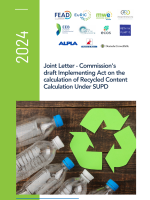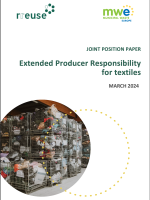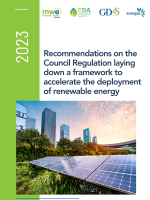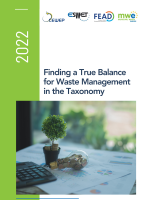Joint Proposal for a Compromise decision on agreeing one measurement point for recycling and one calculation method
Over the last three to four years of discussions on the revision of the Waste Framework Directive, one of the most challenging issues has been finding agreement on the point at which, in the collection, sorting and recycling process, to measure recycled quantities. There are two main aspects to this difficulty: one is the difference in the understanding of which step is called recycling and the other is differences in this process between the various materials. As the European institutions approach the end of this revision process, experts in the field such as the co-signatories to this paper can see that presently, the current solutions proposed: average loss rates and input to final recycling, would present insurmountable barriers to implementation. To overcome this, our proposal is to pinpoint one point of measurement for this revision which is manageable for all Member States, municipalities and recyclers, accepting that it will be implementable if imperfect, which will lead all Member States towards one harmonised, verifiable approach through continued negotiations in the four years leading up to the following revision. For the purposes of achieving a workable compromise in this revision, that point of measurement of recycling is at the output of the last sorting operation, before the material for recycling enters recycling.
This is also the logical point of measurement, together with documented control measures. Currently there are no common standards or industry specifications for the quality of all material streams leaving the last sorting operation. Therefore in some cases further sorting and cleaning is necessary during the recycling process, which sometimes leads to significant losses of material during recycling. The establishment of common standards is therefore advocated. These standards should ensure that waste leaving the last sorting step can be recycled without further significant material losses. As co-signatories, we accept that the development of these standards within 2017 is not possible, therefore we accept a temporary if imperfect solution for now, provided that these standards will be developed before the next revision in 2024. Priority should be given to material streams for which there are no existing quality standards or industry specifications. In the meantime, for this revision, existing European or International quality standards or published industry specifications should be applied in this revision.
The European Institutions and Member States are not ready at this stage to enter into a calculation method which focuses on the specificities of each material and their individual paths through collection, sorting and processing to recycling. For this reason we propose a 2-step path to achieving precision in the measurement and calculation of recycling rates, as explained below.
Step 1 – A temporary solution to measuring recycling in this current revision of the Waste Framework Directive:
The measurement point should be after the last sorting operation (when no further sorting is required, including when the result of a sorting operation meets adopted end-of-waste criteria, industry specifications or standards).
For this revision, existing European or International quality standards or industry specifications should to be applied at EU level in this Step 1, with official recognition in the revised Waste Framework Directive in an annex for this purpose.
Control measures: written documentation proving sale of recyclable materials (e.g. bill of sale with at minimum information on: seller, buyer's details and description, type of waste, quantity, price. Any broker or dealer must store and provide the bill of sale with identity of final buyer) and proving acceptance of waste at the recycling plant where the waste will be recycled, e.g. certificate of receipt at the recycling plant where the waste will be recycled, or integration of this information in an existing form or other suggestion to ensure traceability with verification that the secondary raw material has been integrated into a new product. These documents will be kept for a minimum of five years, for inspection by independent national competent authorities which will safeguard sensitive commercial information.
Inspections by national competent authorities, as relevant, suggested by the revision currently under way.
Step 2 – for the revision to begin in 2024:
Standards for waste materials (including material sub-types) that describe how to define quality criteria, beginning with the materials which have high loss rates need to be developed. The standardisation process could be steered by the European Committee for Standardisation (CEN) or other relevant standardisation bodies, and when relevant, minimum requirements based on these standards should be incorporated into EU waste law or the full standard can be officially recognised in the waste directives. The involvement of all relevant stakeholders including the European Commission is required in this process. This process should begin directly after the adoption of the current revision of the waste legislation. The use of standards or industry specifications per material, whether new or existing, will help in the building of trust in the quality of the materials available on the market and thereby strengthen demand for them.
All of Step 1.
Calculation of municipal waste Recycling Rate for the purposes of the Recycling Target:
Tons waste separately collected (a) – tons recycled (b) = Losses
Tons municipal waste generated - Tons waste separately collected (a) – losses (including sorting resudues, reuse, WtE, disposal) = TOTAL RECYCLED (in tons)
For a %age recycling rate: TOTAL RECYCLED (in tons) / Tons municipal waste generated / x 100 = RECYCLING RATE, e.g. 110 000 tons recycled / 220 000 tons generated = 50% recycling rate
Example, paper recycling:
Paper and cardboard are collected together and will have some plastic content remaining even after the first sorting stage. There will be one or two sorting stages before the final sorting stage which can either be a separate recycling plant or belong to the paper mill. In both cases, the output of the final sorting plant is the point of measurement of recycling. At this final output stage, the total sorted paper graded in accordance with EN 643 quality standard, which sets maximum levels of unwanted materials per grade (with a maximum of 3%), will be weighed and counted as recycled. This is the point where the legislative recycling targets must be met. The sorting residues which will go to landfill or incineration or co-incineration will not be counted as recycling. Recovered paper meeting EN 643 will then go into a pulper. Within the pulper there will be some further losses inherent to any production process, but this is not necessary information for the purpose of measuring recycling rates.
Modifications proposed to Art.11a to implement the above and ensure only one measurement point and one calculation method are adopted in this revision of the Waste Framework Directive:
Art.11a.1(b): the weight of the municipal waste recycled shall be understood as the weight of municipal waste which has undergone all necessary checking, sorting and other preliminary operations to enable high quality recycling without further sorting and will be measured at the point of exit from the recycling operation (which could be the last step of sorting).
Art.11a.2 (new): For the purpose of calculating the overall recycling rate from the weight of municipal waste recycled as per Art.11a.1(b), the following calculation will be used, in accordance with the diagram above:
Step 1: Tons municipal waste separately collected (a) - (tons recycled (b) + (c)) = LOSSES
Step 2: Tons municipal waste generated - Tons municipal waste separately collected (a) - LOSSES (result of Step 1) = TOTAL RECYCLED (in tons)
To calculate the recycling rate per material stream or material type, Step 1 and Step 2 above can be as follows:
Tons (e.g. waste aluminium/polystyrene/white glass/cardboard, etc.) separately collected - tons recycled (sorted, processed into new material or product) = LOSSES
Tons recycled - LOSSES = TOTAL RECYCLED (e.g. waste aluminium/polystyrene/white glass/cardboard, etc.)
Art.11a 2 and 3: DELETE
Art.11a.4: Member States shall establish an effective system of quality control and traceability of the municipal waste to ensure that conditions laid down in paragraphs 1(a), (b) and 2 of this article are met. [...] This system will include the auditing of bills of sale from the last sorting plant and/or recycling plant as well as the auditing of certificates of receipt by the purchasing (or production) plant by an independent competent national authority. In the case of sale of recycled materials through a broker or dealer, these will be registered traders and will keep their bills of sale for a minimum of five years, for the purpose of auditing. Each bill of sale and certificate of receipt (or signed transport document) will include the following information: name and contact details of the seller, name and contact details of the buyer, type and quantity of recycled material purchased. This system may consist of electronic registries set up pursuant to Article 35(4). Any existing, adopted international, national or industry specifications or quality standards can also be used by sorting and recycling plants and by the national authority as part of the audit to ensure the reliability and accuracy of the data gathered on recycled waste.
The Commission will ensure that by 2024, quality specifications or standards, end-of-waste criteria or industry specifications are available for each waste type and that these are integrated into the quality control method of this article to ensure reliability and accuracy of the data gathered on recycled waste.
Thanking you for your extensive analysis of these legal texts and in advance for your careful consideration of this compromise proposal which will facilitate the implementation of this noteworthy revision,
Vanya Veras, Secretary General, Municipal Waste Europe
Valeria Ronzitti, Secretary General, European Centre of Employers and Enterprises providing Public Services and Services of General Interest





